Are you a Quiet Speculation member?
If not, now is a perfect time to join up! Our powerful tools, breaking-news analysis, and exclusive Discord channel will make sure you stay up to date and ahead of the curve.
Well, you know what they say: the more things change, the more they stay the same. The month of July saw some metagame shifts portended the month before take concrete form, as the paper shares adjusted to more closely resemble MTGO results. Death's Shadow Zoo, Dredge, and Eldrazi ascended to Tier 1, replacing Abzan Company and RG Tron. We're still seeing a pretty large discrepancy between the online and paper metagames, however, with Death's Shadow and Dredge hovering around the 10% posted last month.
Riding atop it all is none other than the glorious Jund---the only archetype to rival Death's Shadow and Dredge's dominance on MTGO, while also boasting the clear "best deck" status with a full 3 percentage points above Affinity in the overall metagame share. As I said, some things never change, and the sun never sets on certain empires---all hail King Jund.
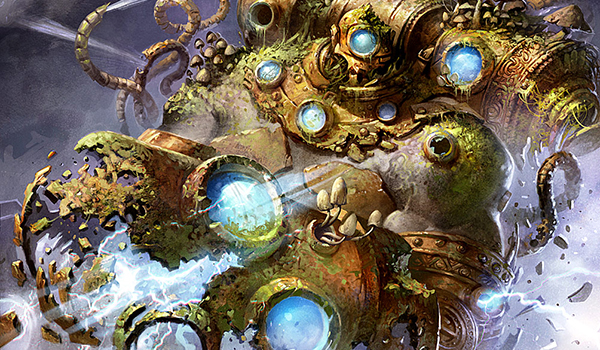
The metagame overall seems to be in flux as the major events available to inform players' deck choices are getting increasingly older. Some uncertainty exists surrounding the upcoming August Grand Prix weekend when Modern will come to the big stage in Lille, Indianapolis, and Guangzhou.
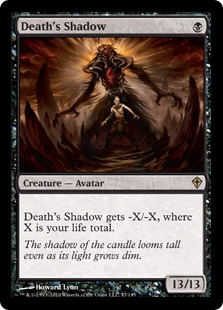 The MTGO data are showing a pretty ossified environment, which leads me to believe the grinders and pros have successfully iterated the format to a stable place. As a result, I still think we'll see the paper metagame shift more towards Jund, Death's Shadow, and Dredge, which are all posting commanding shares on MTGO. But there are enough random elements in Modern to throw some of that homogeneity out once we get to the Grand Prix circuit, where people will inevitably pick up whatever they fancy and/or own. With Dredge specifically, there's also a chance that everyone gets the memo in time and comes packing ample hate to keep it down.
The MTGO data are showing a pretty ossified environment, which leads me to believe the grinders and pros have successfully iterated the format to a stable place. As a result, I still think we'll see the paper metagame shift more towards Jund, Death's Shadow, and Dredge, which are all posting commanding shares on MTGO. But there are enough random elements in Modern to throw some of that homogeneity out once we get to the Grand Prix circuit, where people will inevitably pick up whatever they fancy and/or own. With Dredge specifically, there's also a chance that everyone gets the memo in time and comes packing ample hate to keep it down.
It's important to remember that while MTGO is hyper-efficient at solving metagames and generating consistent competitive finishes, it can also be something of a self-fulfilling prophecy as it becomes inbred and self-referential. I'll be listening, reading, and watching the pros in the coming weeks to see if they're favoring anything in particular, or if the consensus seems to be to play what you know. My guess is the truth lies somewhere in between the two extremes.
[wp_ad_camp_1]
Data Collection Methods
Editor's note: Due to an error in the spreadsheet reporting GR Tron decks incorrectly on MTGO, some initial numbers in this article were wrong. They have subsequently been corrected, along with updates to the discussion. This did not affect broad conclusions about the metagame.
The month of July was a relatively quiet one for Modern events---our only major paper events for this period consist of three Star City Games Classics, in Worcester, Columbus, and Baltimore. In light of this we elected to use the Major Paper Event Day 2 data from June, weighted at one third the normal amount to reflect a decaying influence. Undoubtedly many players are still turning to the SCG Dallas Open for their metagame information and deck choices, but they also may be defaulting to the smaller, more recent Classics or simply their own local scenes. To account for the relative instability in the metagame data, we've set the cutoff for Tier 1 somewhat lower this month, which helps account for the uncharacteristic Tier 1 lineup.
In total there were 117 paper events to draw from, representing 894 decks. MTGO events were more exciting in comparison, featuring both a PTQ and a MOCS besides the usual rash of daily League finishes. In total MTGO contributes 351 decks over 32 events to this month's data set. That's a total of 1245 decks that inform our metagame breakdown today.
As per usual, more detailed information about the methodology and algorithms behind the tiering system can be found on the Top Decks page.
Tier 1
Tier 1 decks are the ones you should expect to face at every Modern tournament. Make sure you show up to your local events and Grand Prix alike with a well thought-out plan to beat these decks---you're going to face them often, and each one is resilient enough to fight through a lackluster counterplan. Of course another avenue is to pick one of these up yourself, which I generally suggest for anyone not well-versed in a lower-tier deck. Whether you know one of these archetypes inside-out and can tune a killer sideboard for the field, or you want to pick up something new and wing it, these decks certainly have the chops to get the job done.
Tier 1: 7/1/16 - 7/31/16
The metagame percentage shares across Tier 1 form a gradient without any sharp drops, which continues into the first few Tier 2 decks. We set the boundary around 4%, which corresponds roughly to the 6+ point cutoff. This makes sense to my eye especially given the MTGO data. Besides Jund, Dredge and Death's Shadow are the only Tier 1 decks on MTGO, and here the dropoff to Tier 2 is pretty marked, from 9.2% (Jund) to 6.7% (Affinity).  The paper metagame is much more varied. In any case, depending on definitions the bottom half of these decks could be considered Tier 2, and we should expect some upsets as the Grand Prix weekend establishes more firmly what's top dog.
The paper metagame is much more varied. In any case, depending on definitions the bottom half of these decks could be considered Tier 2, and we should expect some upsets as the Grand Prix weekend establishes more firmly what's top dog.
Last month, I predicted that controlling decks would fall prey to the highly linear metagame we're in the midst of right now. Jeskai and Jund are still doing their thing (although Jeskai has dropped a bit), but the slow and durdly Tron looks to be the first real casualty. I'm not sure I relish trying to fight through infinite Become Immenses and Atarka's Commands from the Tron side of things, to say nothing of the explosive Dredge deck. Building Tron to combat one or two or these decks isn't hard, with access to Anger of the Gods, Ancient Grudge, Fog, Spellskite, or Grafdigger's Cage. But Tron doesn't have a lot of wiggle room in its maindeck configuration, and trying to play sideboard roulette in this meta doesn't seem like a good idea.
 Jund and Jeskai, however, get to enact the "kill every last one of your nonsenses" plan against these aggressive decks, without drastically altering their card choices. They can also present a fast clock (whether in the form of Tarmogoyf or Nahiri ultimate) to avoid dying to top-decks. Both seem well positioned in a field full of aggro and creature-based combo.
Jund and Jeskai, however, get to enact the "kill every last one of your nonsenses" plan against these aggressive decks, without drastically altering their card choices. They can also present a fast clock (whether in the form of Tarmogoyf or Nahiri ultimate) to avoid dying to top-decks. Both seem well positioned in a field full of aggro and creature-based combo.
Something I didn't discuss in the last update, but which remains true this month, is that we're seeing a relatively fair top-tier metagame. Dredge is on the rise, certainly, and Infect is still kicking around, but neither of these are decks that "do unfair things unfairly." Their combo elements are still highly interactive and tend to make use of the combat step, unlike something like Ad Nauseam or Storm. In any case, the rest of the field is a bunch of aggro, midrange, and control decks that try to play "normal" Magic. Whether you're longing for diversity or interesting back-and-forth games, it looks to be a great time to play Modern.
Tier 1 Changes: June to July
We've already discussed the rise in Death's Shadow and Dredge. The other big gainer here was Eldrazi, mostly in its by-now de facto standard version, Bant. As a fair deck that goes slightly bigger, Bant Eldrazi seems well suited to a field of aggro decks and creature combo. It's capable of presenting a fast clock to pressure controlling decks, while giant bruisers like Thought-Knot Seer and Reality Smasher combine with Drowner of Hope and Eldrazi Displacer to control the aggressive decks' board states.
 Infect, on the other hand, loses a significant chunk of share to the rising archetypes, falling almost a full 3 percentage points. This effect is even more pronounced if you discount the Day 2 data from June that's still forming a portion of our data set. I'm not entirely sure why Infect wouldn't be performing in the developing environment, but I can say it struggles against Dredge and Jund. And it probably hasn't helped that Tron is on the way down, removing one of Infect's favorite and most vulnerable sources of prey.
Infect, on the other hand, loses a significant chunk of share to the rising archetypes, falling almost a full 3 percentage points. This effect is even more pronounced if you discount the Day 2 data from June that's still forming a portion of our data set. I'm not entirely sure why Infect wouldn't be performing in the developing environment, but I can say it struggles against Dredge and Jund. And it probably hasn't helped that Tron is on the way down, removing one of Infect's favorite and most vulnerable sources of prey.
Dredge becoming such a prominent part of the metagame throws a wrench into sideboard plans, and people are probably going to start dedicating more of that coveted space to Grafdigger's Cage and friends. If they overcompensate by cutting their Affinity hate (which is also appealing in a metagame where Tron is declining) the robots could be ready to take over. Of course by overall metagame share they're already in the second spot behind Jund---I wouldn't advise skimping on the artifact hate.
Tier 2
Tier 2 decks are not as omnipresent as the Tier 1 crop, but they still show up in hearty numbers at the typical tournament. In many ways this tier is the lifeblood of Modern, whence its diversity and "play anything" reputation stems. If these decks aren't dominating at the moment, they're still capable of crushing a tournament on any given day---and most of them have been Tier 1 at some point in the past or will in the future. The better acquainted you are with any one of these archetypes, the better choice it represents, and if one of them is your specialty there's a strong argument to stay the course and keep sleeving it up.
As for preparing to beat Tier 2 decks, you don't need to dedicate specific sideboard space or do backflips to make your matchups favorable, but at minimum have a plan. You won't face all of these decks in a tournament, but you're all but certain to face at least some of them. Welcome to Modern!
Tier 2: 7/1/16 - 7/31/16
As I explained above, the first couple archetypes here segue more or less smoothly from the Tier 1 decks. This represents a diverse but ill-defined metagame, where Tier 1 and Tier 2 bleed into each other. It's no coincidence that two of the three 3%+ archetypes were Tier 1 last month, and they could easily be slated for a rebound.
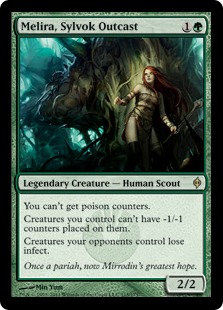 Abzan Company joins Tron in falling back to Tier 2, continuing its gradual decline since Eldrazi Winter. Company continues to post poor to abysmal MTGO numbers (0.8%), suggesting the Dredge/Death's Shadow/Jund trifecta metagame may be hostile to them. However, I'm assured that Abzan Company should have reasonable matchups in this environment, which lines up with my intuitive understanding of the archetype. It seems likely that the difficulty of executing the combo on MTGO is a significant factor in the disparity between its online and paper shares.
Abzan Company joins Tron in falling back to Tier 2, continuing its gradual decline since Eldrazi Winter. Company continues to post poor to abysmal MTGO numbers (0.8%), suggesting the Dredge/Death's Shadow/Jund trifecta metagame may be hostile to them. However, I'm assured that Abzan Company should have reasonable matchups in this environment, which lines up with my intuitive understanding of the archetype. It seems likely that the difficulty of executing the combo on MTGO is a significant factor in the disparity between its online and paper shares.
For its part, Tron obviously loves to beat up on Jund. But it has a pretty grueling gauntlet to get through in the rest of its matchups, where the two Tier 1 newcomers are joined by traditional problem matchups like Infect and Burn. As for the rest, Ad Nauseam has gained a bit since June (from 2.4% to 3.1%) while Grixis Delver and Kiki Chord have dropped; other than that things haven't changed much.
Tier 3
Tier 3 in Modern houses the decks with fringe potential, or those which are simply in a poor position in the current metagame. These decks range from relatively strong decks with scant adoption in the player base, to fragile decks that crumble to variance while mainstays like Burn or Jund draw consistently round after round. That said, Modern draws from an absurd well of card power, and each of these decks can give you a run for your money. You don't need perfect knowledge of everything they're doing, but the difference between familiarity and complete ignorance can definitely determine the outcome of a match.
Playing these decks isn't advised, unless you know them inside-out or have some specific reason why you think they're underrepresented. Of course, they are also worth a look as fun decks to battle if you're less concerned about winning and want to delve into the deeper end of the Modern pool.
Tier 3: 7/1/16 - 7/31/16
Largely this is the typical smattering of Tier 3 archetypes we see month to month. A few bear mentioning because they're relatively novel, and one because its share is dictated almost exclusively by one person. 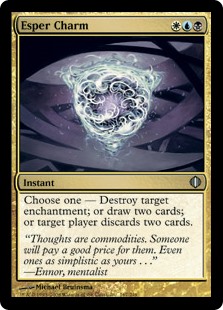 Trevor wrote recently about the Esper Control deck that Guillaume Wafo-Tapa has been developing---the hall-of-famer has been crushing people pretty roundly in the daily League results, posting multiple finishes with his beloved durdle control deck (yep---that's the full four Think Twice in Modern, you better believe it).
Trevor wrote recently about the Esper Control deck that Guillaume Wafo-Tapa has been developing---the hall-of-famer has been crushing people pretty roundly in the daily League results, posting multiple finishes with his beloved durdle control deck (yep---that's the full four Think Twice in Modern, you better believe it).
It's hard to see these results and avoid concluding that Wafo-Tapa's exceptional play skill is allowing him to overcome an archetype disadvantage. After all, this is a man who has regularly chosen to draw first in Constructed and still beaten the crap out of everybody, and his unorthodox theory and choices obviously work well for him. We'll see if this draw-go version of Esper Control picks up, but for now I'm chalking it up to the Frenchman's mad genius.
Another strange deck has been popping up in the League results: a combo deck in Jeskai colors built around Pyromancer Ascension and Thing in the Ice. A few other players have adopted Thing in the Ice in their UR Pyromancer Ascension Storm decks, but what's strange about this newest version is the complete removal of the storm cards themselves. 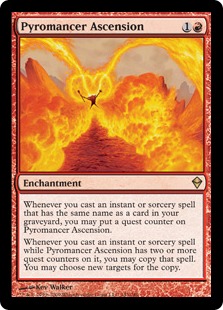 There's no Past in Flames or Grapeshot to go completely nuts with---the deck looks to win more honestly by flipping a Thing, or doubling up on Lightning Bolts and Helixes like the old Ascension deck from Standard past.
There's no Past in Flames or Grapeshot to go completely nuts with---the deck looks to win more honestly by flipping a Thing, or doubling up on Lightning Bolts and Helixes like the old Ascension deck from Standard past.
With things like Remand, Visions of Beyond, and more interactive spells in the sideboard, this deck plays like a control deck. In the vein of old Jeskai, its goal is to delay opponents long enough to string together the right number of Bolts to face.
Finally, Soul Sisters looks to be on an uptick. Most of the versions comprising its 1.7% MTGO shares are mono-white, but one or two are splashing black. The deck has a pretty wide variety of different builds, some focusing more on the Martyr of Sands-Proclamation of Rebirth interaction, some more on token production via Spectral Procession or Lingering Souls. There appears to be little consensus on the best build of the deck, but for whatever reason it's working out for some people in the MTGO queues.
Predictions
My predictions from the June breakdown centered around Dredge's and Death's Shadow's ascent look to be at least partially true. The MTGO results haven't really migrated to paper, but the archetypes' dominance online continues unabated. We also saw GR Tron fall in the wake of all the linear aggro decks' rise. Scapeshift, however, failed to materialize as a major player as I thought it would.
I'm pretty hesitant to make predictions for the coming Grand Prix weekend. Partly because the gradual sliding scale of metagame shares shows a format that's unsure of itself, and partly because we've had several months of reduced activity in the Modern tournament scene. I trust the pros will come up with one or two archetypes whose positioning the community at large has misevaluated, but this really doesn't look like a broken metagame where one thing will dominate. I expect archetype specialists to stand by their favorite weapon, and I expect the three Grand Prix Top 8s to exhibit a diverse range. We'll see exactly how it shakes out soon.
Naming Convention & Archetype Primers
One thing I've noticed as I've learned more about the metagame breakdown is an inconsistency in labeling conventions, which I hope to resolve for next month. The major archetypes are pretty much represented the same way each time, but there's some work to do on the rarer and harder-to-classify decks. 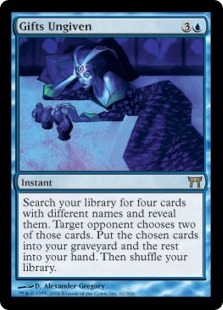 This is especially noticeable in the archetypes that form a continuum from one type of build to the next. I mentioned Scapeshift and Valakut decks as one culprit last month. Some other ones are Gifts Ungiven decks (ranging across many colors and omitting or including Thopter Foundry), Death and Taxes (which forms a gradient with Hatebears of creature-prison decks), and four-color control decks, which are represented by a mess of different labels right now.
This is especially noticeable in the archetypes that form a continuum from one type of build to the next. I mentioned Scapeshift and Valakut decks as one culprit last month. Some other ones are Gifts Ungiven decks (ranging across many colors and omitting or including Thopter Foundry), Death and Taxes (which forms a gradient with Hatebears of creature-prison decks), and four-color control decks, which are represented by a mess of different labels right now.
Sheridan and I are looking to standardize some of these naming conventions in the near future. This will coincide with the development of the major archetype primers in the works. As I find authors with specific archetype knowledge to help us fill out the Primers page, we'll consult with them on what they consider to be that family of deck's closest cousins, how the different variants play out, which card choices are indicative of them, and so on. There will obviously be some disagreement on the classification scheme as things get ironed out, but I hope you'll join us the lively debate that will no doubt ensue.
On that note, we're still looking for folks to help write archetype primers---that could be you! This is a great opportunity to get your name out there, contribute your unique understanding of a niche Modern deck, or just try your hand at strategic writing. The process of selecting each author may take a few weeks, but we'd love to hear from you! Send any offers/requests/questions my way at jason@quietspeculation.com.





Interesting developments in this update. Tron’s dip is somewhat interesting given how much Jund is out there, but I guess smashing that ~10% of decks doesn’t make up for all the fast linears that simply ruin your day if you happen to bump into them. It’s interesting to see Living End bouncing back in a time where Dredge is ascendant (and thus everyone should be scrambling to cram in more graveyard hate), but here we are. Grixis’ demotion to Tier 3 has been a long time coming – the deck has beeen hanging on, but the ascension of Nahiri, the Harbinger snatched the control playing crowd away pretty much for good.
Sisters at Tier 3 is an absolute shock – that deck has been lurking in the non-tiered morass forever, and I don’t really think Lone Rider was enough to propel it into this level of discussion. Burn’s meta share isn’t particularly high for its standards, so I’m wondering what’s fueling it right now.
The rise of living end might have to do with the fact that grafdigger’s cage has no effect on it. People try to hit as many decks as possible with their limited sideboards and cage is very efficient, helping against coco, nahiri, and dredge. It’s also an easy inclusion in a lot of decks since it is colourless and only 1 mana.
Aye, but so is Relic of Progenitus, and while it doesn’t kill Dredge or Abzan Company as dead as the Cage does, it demolishes Living End in addition to powering down Jund’s Goyfs and shutting off Nahiri’s Snapcasters pretty effectively. I guess most people are opting for the fire-and-forget power of the Cage (I own both, but I’m only rocking Relic for the time being).
I think the heavy weight of MTGO results in this update is contributing to Abzan Company’s fall from Tier 1. 4.1% paper share is above your 4% tier 1 breakpoint, while the .8% share MTGO is pulling it down way more than you’re giving credit for. It seems like you’re glossing over that the company combo in MTGO, unlike paper, is incredibly unwieldy and can lose the player a lot of time to execute, especially if it’s only the infinite life combo which requires half a dozen clicks per 2 life increment and so doesn’t get the “I’m at one million life” that causes most decks to concede.
*Looks at Mono U Tron deck*
Awesome, running the worse version of a deck that doesn’t fit the overall meta lol. Oh well, still fun to play.
He actually accounted for that in his writeup. Regardless of the reason why a deck may not be particularly prevalent on a given platform (for example, Merfolk was kept out of Tier 1 for months thanks to a Kira, Great Glass-Spinner bug squashing its metagame share), if the results aren’t there, he has to demote the deck.
For what it’s worth, this section has been rewritten to highlight this phenomenon more explicitly. The more I’ve thought about it, the more it seems this is the principle cause of the paper/MTGO disparity in Abzan Company results.
Itd be interesting to see the % share of decks over time since modern nexus started tracking. So like in the past two years how did jund trend overall? Are there noticeable trends like infect going up when tron goes down? What decks consistently hover at the same percent and what ones do more ebb and flow? What decks have died out? Certainly the explanation involves banlist changes and new cards – but could still be very interesting to see and pretty easy to compile!
This is an awesome idea, and I’m surprised we haven’t done it yet. Something I will keep on my docket for when we find time. I could also just write a one-off article on it, if that sounds interesting to people.
I would certainly be interested in something like that. Especially if it came with some nice graphical representations.
With the debate between graveyard hate and artifact hate going on in this article, I want to take the time to remind everyone of a certain card: Rakdos Charm. If it’s in your colors, it can destroy artifacts or exile graveyards at instant speed. It’s also great against go-wide decks (I’ve gotten seven damage off this card before). Great way to punish Affinity, Dredge, Grixis Delver/Control, Elves, Merfolk, Kiki Chord–probably more, and for the purposes of the graveyard versus artifact debate, it’s a great way to turn 4-6 sideboard slots into 2-3 sideboard slots.
Ah yes, the oft forgotten yet ever useful swiss army knife of modern. Also the scariest 2 mana card to represent against a twin player.
remember that if your opponent decides to make infinite creatures, you can simply charm their face for infinite damage and win the game. observant, and seasoned players will know to play around it, but I think kiki chord players will certainly not expect to get killed by rakdos charm, at least in paper.
Wonder if Esper of Bant spirits will be on the tier3 list next month. Seems solid.